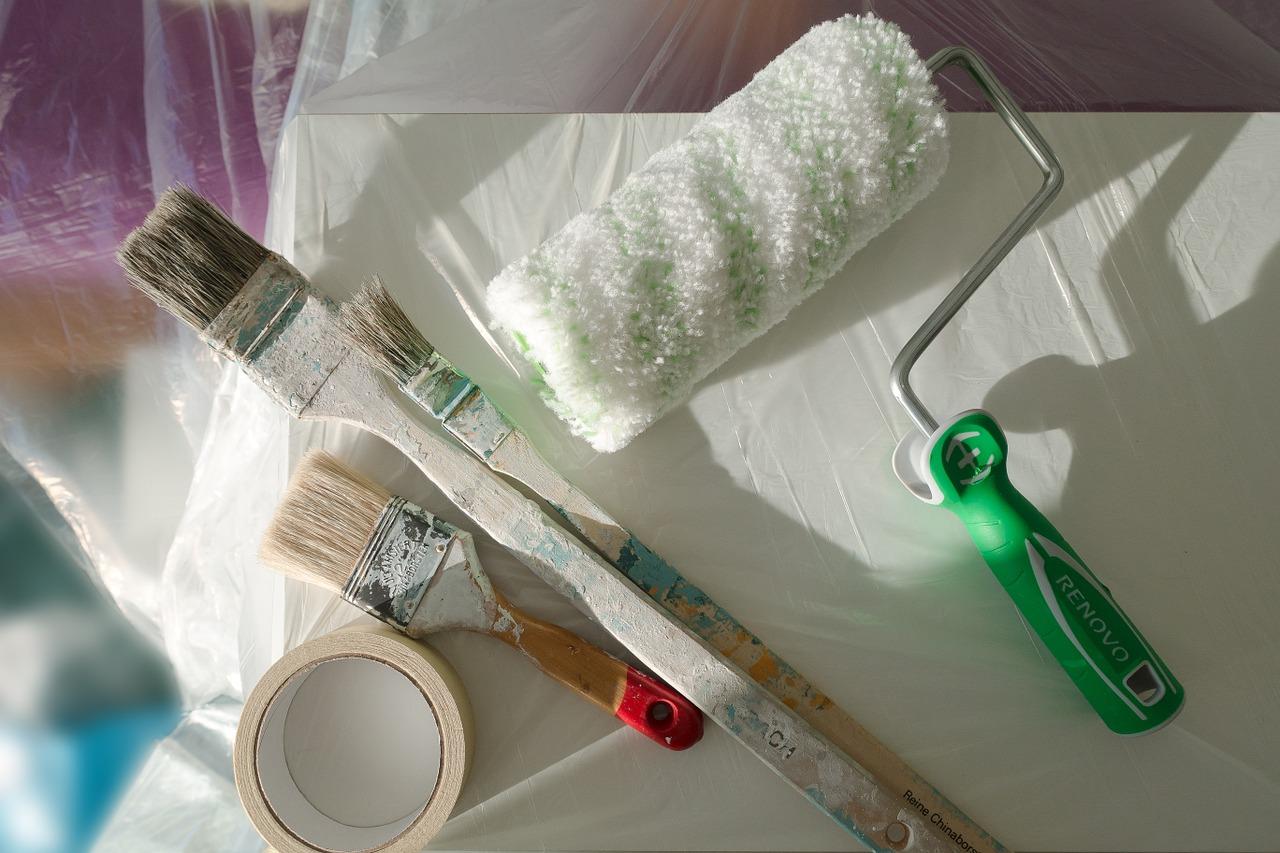Masking Tape vs Painters Tape
Painters tape and masking tape have a lot in common. Many people opt to use masking tape instead of painters tape because it's cheaper. Sometimes the substitution works just fine. But other times DIY-ers go to remove their masking tape and find seepage or residue.
When can you use masking tape, and when is painting tape your best option? By understanding the two types of tape, you can proceed with confidence — saving money without sacrificing quality.
What’s the Difference Between Masking Tape and Painters Tape?
Painters tape is actually a special kind of masking tape. “Masking” is the act of protecting a surface from change. In this case, you want to protect the wall from paint.
As a result, commercial masking tape and painter’s tape share many features. Both are:
- Made with crepe-paper backing
- Easy to tear by hand
- Easy to write on and use as labels
- Easy to find
- Used to achieve a straight, crisp line
The main difference is in the adhesive. Masking tape uses a natural rubber adhesive that can leave a residue or allow seepage. Painter’s tape is specifically designed to avoid these problems.
Each product has its strengths and weaknesses. The trick lies in choosing the best option for your project.
Here’s a quick run-down of the pros and cons for each.
Masking Tape Pros
Masking tape has many benefits. It:
- Leaves clean, straight lines
- Is easy to find
- Is cheaper than painter’s tape
- Is great for painting on window or canvas
Masking Tape Cons
On the other hand, masking tape also:
- Can leave behind a sticky residue that is hard to clean
- Must be removed within hours of application for clean removal
- Can peel up paint if it sticks to the tape’s surface
- Can buckle under water-based paint, which allows paint to seep below the tape
Painters Tape Pros
Painters tape also has many benefits. It:
- Leaves clean, straight lines
- Is easy to find
- Won’t pucker or buckle no matter what type of paint you use
- Can be left on a surface for several days after painting and still be removed without any problems
Painters Tape Cons
The only real con of painters tape versus masking tape is the price. For smaller projects, this isn't a big deal, but on larger ones, the difference can start to add up.
While painter’s tape is the safer option for most painting, you may need to cut costs on larger projects or switch over to masking tape when working on surfaces such as canvas or glass.
When Should You Use Masking Tape?
Masking tape is easy to use and highly flexible, making it a great staple to have around the house. Get it out when you’re crafting, painting on canvas, or in need a bit of tape.
You can also use it when painting around your windows. Masking tape removes from glass cleanly enough that there’s no need to use the pricier painter’s tape for glass surfaces.
Masking tape also comes in handy in various life hacks:
- Use it to label foods, toys, boxes, etc.
- Attach torn hems or fix other wardrobe problems while waiting to get to the tailor.
- Pick up broken glass, particularly tiny shards.
- Use it as an emergency lint roller.
How to Remove Masking Tape Residue
In addition to seeping paint, the major danger masking tape poses to your walls is stubborn adhesive. As the tape sits on the surface, the adhesive settles in, becoming more and more firmly fixed. In extreme cases, it can even damage drywall as you struggle to remove it.
It’s definitely better to prevent the problem in the first place. Painter’s tape won’t give you the same headaches. Quality tapes also come with labels that indicate how long you can leave them on a surface before removing them. This clean removal time can vary from several days to several weeks.
But if you do find yourself wrestling with dried out tape, there are a few methods that may help loosen it:
- Warm water. Rub a warm, damp cloth over the tape. Wait a few minutes, and try to remove the re-moisturized tape.
- Hair dryer. Go the dry route, gently heating up the tape and softening the glue from several inches away. Then try to remove it.
- Soaps and lubricants. Commercial products can also help you moisten and reactivate the glue. Try products designed for use with wood.
Once you have the bulk of the tape off, you can work on remaining residue with a razor or a solvent such as Goo Gone.
When Should You Use Painters Tape?
Use painter’s tape for both professional and do-it-yourself paint jobs.
In addition to protecting blank surfaces, you can also use it to create designs on your walls and doors. Try out one of these fun projects and patterns :
- Diamond, herringbone, and hexagon patterns. These make great accent walls. Layer different colors or keep the pattern lines white.
- Fake trellises. Bring outdoor detail inside. Take this to the next level by adding garden-appropriate flourishes such as creeping vines or flowers.
- Stripes and borders. Add a bold splash of color to the center of a wall or create a faux wallpaper strip that borders the walls.
- Plaids and argyles. You can paint furniture, too. A plaid table adds a great touch of whimsy to a room.
- Custom stair risers. Paint wooden staircases for a one-of-a-kind climb.
How to Use Painter’s Tape
Any home-improvement project can be compromised by human error. By properly applying your painters tape, you can minimize this possibility.
Use painters tape to create crisp edges around the area you’re painting. After protecting the surface you don’t want painted, try these two tips to ensure painting perfection.
Painters Tape Tip #1
If your tape isn’t perfectly smooth, paint can sneak underneath. Slow, careful application will give you a fairly even surface, but you can get your tape to lie perfectly flat by further smoothing it out with an old credit card.
Painters Tape Tip #2
When painting, sweep the paint away from the tape instead of towards it. You don’t want to run the risk of pushing paint under the tape.
What Does Tape Jungle Recommend?
Tape Jungle carries both the highest quality painter’s tape and the best general purpose masking tape. You can even purchase custom tape branded with your company’s logo.
You’ll want to find the right tape in the right width for your project. You may also want to consider quantity. While some of our tapes are available in subpacks, others are offered by the case.
Best Masking Tapes
It’s easy to find masking tape, but not all masking tapes are created equal. Here are our favorites.
TALON General Purpose Masking (22263)
Talon masking tape is a utility grade tape good for a variety of applications. It resists curling and can handle light-duty packaging, bundling, and holding.
Comes in widths of ¼” (6mm), ⅜” (9mm), ½” (12mm), ¾” (18mm), 1” (24mm), 1.5” (36mm), 2” (48mm), 3” (72mm), 4” (96mm), 6” (144mm), and 12” (288mm).
INTERTAPE General Purpose Masking (MTGPI)
Intertape masking tape is another all-purpose product. It’s especially good for work with fabric, including carpet seaming and silk screening.
Comes in widths of ½” (12mm), ¾” (18mm), 1” (24mm), 1.5” (36mm), and 2” (48mm).
ALANSON PRODUCTS Color Masking Tape (25963)
Alanson Products color masking tape is perfect for color coding and decorative edging. It comes in multiple colors:
- Black
- Blue
- Green
- Red
- White
- Yellow
Comes in widths of ¼” (6mm), ⅜” (9mm), ½” (12mm), ¾” (18mm), 1” (24mm), 1.5” (36mm), 2” (48mm), 3” (72mm), 4” (96mm), 6” (144mm), and 12” (288mm).
Best Painters Tapes
In comparing our painter’s tapes, you’ll find that different tapes are suited to different projects.
TALON Blue Painters Tape (24900)
TALON painters tape is a classic blue tape designed for both indoor and outdoor applications. This tape provides clean removal and UV resistance for up to 14 days of outdoor exposure.
Comes in widths of ½” (12mm), ¾” (18mm), 1” (24mm), 1.5” (36mm), 2” (48mm), 3” (72mm).
ALANSON PRODUCTS Super Blue USA Painters Tape (SB621)
Alanson Products super blue tape can be used for drywall, hardwood, wood trim, and even flooring. You can remove it cleanly for up to 21 days.
Comes in widths of ¾” (18mm), 1” (24mm), 1.5” (36mm), 2” (48mm), 3” (72mm).
INTERTAPE AquaMask Medium Grade Painters Masking Tape (MTAMI)
Intertape AquaMask is a strong tape, suited to most paint masking applications and compatible with both water and solvent-based paints. It’s UV resistant up to three days, and has the highest temperature resistance available. It can withstand temperatures up to 225℉ for 30 minutes.
Comes in widths of 1” (24mm) and 2” (48mm).
Best Tape for You
Unless you’re working with glass or canvas, painter’s tape is the best option for most home-improvement needs. You don’t want to compromise your work with sloppy edges or tape that refuses to let go. Instead, choose tapes specifically designed to be used for painting preparation.
Use masking tape for canvases, labels, and everyday sticky situations. Our fun colors also delight children of all ages, making them perfect for arts and crafts or easy color-coding. There’s no limit to the amazing projects you can complete with Tape Jungle products. Contact us with any questions, and we’ll help you find the tape that best fulfills your purpose.


 Canadian Dollar
Canadian Dollar
